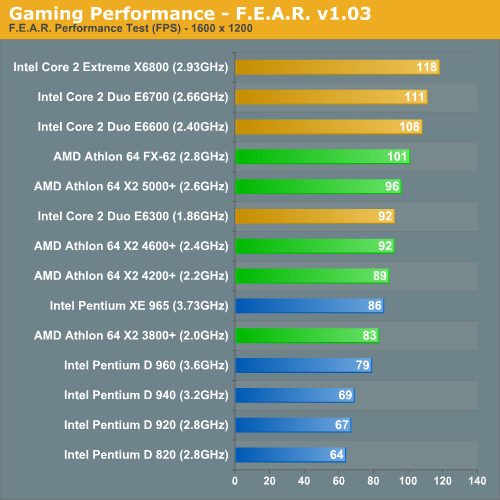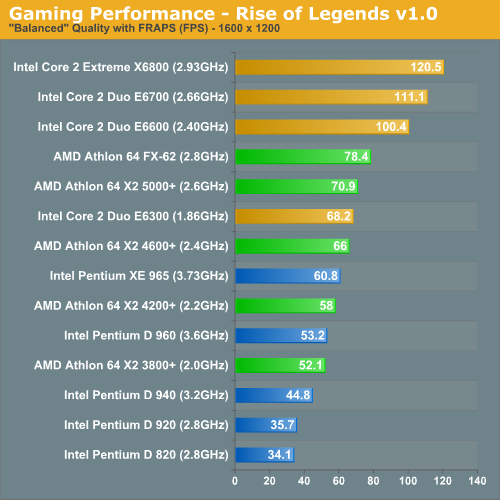Intel's Core 2 Extreme & Core 2 Duo: The Empire Strikes Back
by Anand Lal Shimpi on July 14, 2006 12:00 AM EST- Posted in
- CPUs
Gaming Performance using F.E.A.R. & Rise of Legends
Our F.E.A.R. test should be fairly familiar by now, as it is the built in performance test included with the game. Computer settings were left at "Maximum" while the graphics settings were set to "High" with the resolution cranked up to 1600 x 1200. F.E.A.R. ends up still being more GPU than CPU bound at these settings, even with a pair of X1900 XTs at its disposal, but we do see some separation among the processors:

The top three spots still go to the top three Core 2 CPUs, with the E6300 falling around the level of the X2 4600+. A trend that we've been seeing all throughout this review is that the performance of these CPUs effectively falls into three groups: Core 2 processors at the top, Athlon 64 X2s in the middle and Pentium D at the very bottom of the charts. In a sense that's the easiest way to classify these three groups of processors: if you want the fastest it's Core 2, mid-range goes to the Athlon 64 X2 and if you don't like good performance there's always the Pentium D.
Rise of Legends is a newcomer to our game benchmark suite and what an excellent addition it is. This Real Time Strategy game looks very good and plays well too; it serves as good filler until the next Command & Conquer title eventually arrives for those looking for a RTS fix. We ran with the resolution set to 1600 x 1200 and the graphics settings set to the medium defaults. We recorded a custom playback of a 3 vs. 2 multiplayer battle and played it back at 4x speed, recording the average frame rate for 10 minutes of the battle. The 10 minutes we focused on contained a good mix of light skirmishes between opponents, base/resource management with very few characters on the screen and of course some very large scale battles.

As with most RTSes, Rise of Legends is extremely CPU bound. The performance variability between runs was fairly high in this test, mainly because of how disk intensive the playback can get. Differences in performance of up to 5% should be ignored, but the standings are correct - the Core 2 line of processors absolutely demolish the competition: you're looking at true next-generation CPU performance here. The E6300 isn't nearly as impressive when compared to its more expensive siblings, but when you compare it to AMD's lineup it looks very good, especially considering its proposed cost.










202 Comments
View All Comments
arachimklepeto - Tuesday, July 25, 2006 - link
And what about noise Core 2 Duo fan(decibels)?bmaamba - Tuesday, July 25, 2006 - link
Hi,Acc. to Toms hardware, for EIST to work, setting in Control panel has to be changed from "desktop" to "portable/laptop".AT guys, was this done? If not, how about putting it in the "Power consumed" graphs?(acc. to Tom(if i rem. right), least power in this mode is about 25watts by core 2 duo!!!).Also anyone knowledgeable, is this setting available in Linux?
Also, how about putting XP X2 3800+ EE in the encoding benchmarks (along with core 2 duo 6300)?
Thanks
Ed
PS.Price and power consumed when idle are v. imp. to me.
herkulease - Thursday, July 20, 2006 - link
Unless I missed it what are temps like on these.Justin Case - Monday, July 17, 2006 - link
What the heck is a "composite score"...? What are the units? How about giving us rendering times (you know, minutes, seconds) and render settings, so the numbers actually mean something...?rahvin - Monday, July 17, 2006 - link
Where's a good 64bit comparison on Linux and a LAMP stack run at 64bit? There hasn't been a serious linux server benchmark posted.BikeDude - Sunday, July 16, 2006 - link
I'd love to see some timings from a C++ compiler or two... Looks like I'll have to revise our standard developer PC configuration.--
Rune
kmmatney - Sunday, July 16, 2006 - link
"Jarred that would be great to see. The E6300 and X2 3800+ seem close, but the final AMD pricing and the overclocking potential of each could really make either the clear winner for performance per dollar in the midrange segment."Yes - this is the test that most people want to see. I';m sure a lot of people are like me, and don't much care about any processors over $200. We want to see that the low end can do!! The AMD X2 3800+ is going to be even lower priced than the E6300, so there may be a good battle at teh low cost end.
aznskickass - Sunday, July 16, 2006 - link
Battle? What battle? The war is over my friend. ;)The E6300 wins hands down vs X2 3800+, even more so once both are overclocked:
http://xbitlabs.com/articles/cpu/display/core2duo-...">http://xbitlabs.com/articles/cpu/display/core2duo-...
Jeff7181 - Saturday, July 15, 2006 - link
Would have been nice to see a Core Duo CPU in there too just for comparison for those of us with laptops who might considering spending $200 on a Merom if it would increase performance 10-20% over a Yonah with the same power consumption.IntelUser2000 - Thursday, July 20, 2006 - link
Link: http://www.trustedreviews.com/article.aspx?art=316...">http://www.trustedreviews.com/article.aspx?art=316...
http://www.hardware.fr/articles/623-10/intel-core-...">http://www.hardware.fr/articles/623-10/intel-core-...
Core 2 Duo E6400 2.13GHz is approximately 15% faster than Core Duo T2600 2.13GHz, in addition to the fact that 4MB cache versions are 3% in average faster, it looks estimation of 10-20% faster per clock than Yonah is right, even with the 2MB cache version.